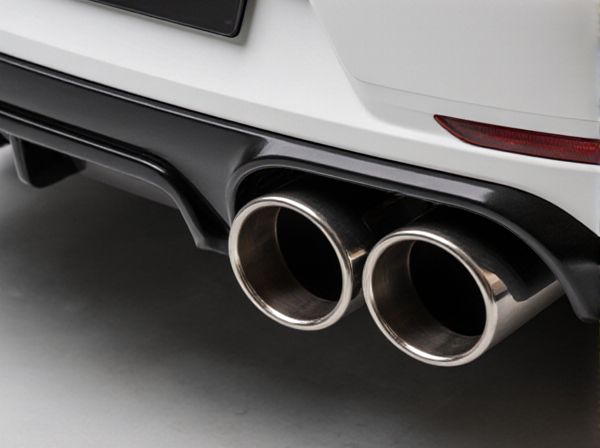
Photo illustration: Titanium System vs Stainless Steel System
Titanium systems offer superior strength-to-weight ratios and exceptional corrosion resistance, making them ideal for demanding environments where durability is crucial. Stainless steel systems are highly durable and cost-effective, providing excellent resistance to rust and wear in a variety of applications. Your choice depends on the balance between performance requirements and budget constraints.
Table of Comparison
| Feature | Titanium Exhaust System | Stainless Steel Exhaust System |
|---|---|---|
| Weight | Lightweight, reducing overall vehicle weight by up to 40% | Heavier, adds more weight compared to titanium |
| Durability | High corrosion resistance, withstands extreme temperatures | Good corrosion resistance, but prone to rust over time |
| Cost | Expensive due to raw material and manufacturing | More affordable, widely available |
| Performance | Improves exhaust flow and sound with minimal heat transfer | Reliable performance, but higher heat retention |
| Lifespan | Long lifespan; maintains integrity for 10+ years | Moderate lifespan; may corrode or degrade after 5-7 years |
| Appearance | Unique metallic sheen, resists discoloration | Shiny finish initially, may dull or stain with use |
Overview of Titanium and Stainless Steel Systems
Titanium systems offer superior corrosion resistance and biocompatibility, making them ideal for medical implants and aerospace applications, while stainless steel systems are valued for their strength, affordability, and wide availability in construction and manufacturing. Titanium's lower density results in lighter components compared to stainless steel, which enhances performance in weight-sensitive environments. Stainless steel systems exhibit excellent durability and ease of fabrication, which ensures their continued use in diverse industrial settings.
Composition and Material Properties
Titanium systems consist primarily of titanium alloys, which feature high strength-to-weight ratios, excellent corrosion resistance, and biocompatibility, making them ideal for medical and aerospace applications. Stainless steel systems are composed mainly of iron, chromium (typically 10-30%), and nickel, offering superior toughness, wear resistance, and corrosion protection in a wide range of environments. The distinct composition of titanium alloys results in lower density and greater fatigue resistance compared to the heavier, more ductile stainless steel, influencing their performance and application suitability.
Strength and Durability Comparison
Titanium systems exhibit superior strength-to-weight ratios compared to stainless steel systems, providing enhanced durability under high-stress conditions. The corrosion resistance of titanium significantly surpasses stainless steel, ensuring longer lifespan and reduced maintenance in harsh environments. Stainless steel, while strong and cost-effective, tends to experience fatigue and corrosion more rapidly, limiting its durability in demanding applications.
Corrosion Resistance Performance
Titanium systems exhibit superior corrosion resistance compared to stainless steel systems due to their ability to form a stable, protective oxide layer that resists aggressive environments such as seawater and chemical exposure. Stainless steel, while corrosion-resistant, is more susceptible to pitting and crevice corrosion, especially in chloride-rich environments, limiting its durability in harsh conditions. Titanium's exceptional resistance to corrosion extends the lifespan and reliability of equipment in marine, aerospace, and medical applications where exposure to corrosive substances is frequent.
Biocompatibility and Safety
Titanium systems exhibit superior biocompatibility due to their excellent corrosion resistance and minimal ion release, reducing the risk of adverse tissue reactions compared to stainless steel systems. Stainless steel may induce allergic responses or inflammation in sensitive patients because of nickel and chromium content. The enhanced safety profile of titanium makes it the preferred choice for implants and medical devices requiring prolonged contact with biological tissues.
Weight and Aesthetics Differences
Titanium systems are significantly lighter than stainless steel systems, offering approximately 40% less weight, which enhances comfort and ease of use in various applications. Aesthetically, titanium provides a sleek, modern metallic finish that resists tarnish and corrosion, maintaining its appearance over time. Stainless steel systems display a more traditional, robust look with a shiny silver color but tend to be heavier and may show signs of wear or rust in harsh environments.
Installation and Maintenance Requirements
Titanium systems offer superior corrosion resistance, reducing maintenance frequency and costs compared to stainless steel systems, which may require regular inspection and passivation to prevent rust. Installation of titanium components demands precision welding techniques, such as inert gas shielding, whereas stainless steel systems allow for more conventional welding methods but require careful handling to avoid contamination. The lightweight nature of titanium facilitates easier handling during installation, lowering labor intensity and time.
Cost and Economic Considerations
Titanium systems typically involve higher initial costs due to expensive raw materials and complex manufacturing processes, while stainless steel systems offer more affordable upfront expenses and wider availability. Despite the higher price, titanium's superior corrosion resistance and longevity can reduce long-term maintenance and replacement costs, enhancing overall economic efficiency in critical applications. Stainless steel systems may require more frequent repairs or replacements in harsh environments, potentially increasing lifecycle expenditures despite lower initial investment.
Typical Applications and Use Cases
Titanium systems are typically used in aerospace, medical implants, and marine environments due to their high strength-to-weight ratio, exceptional corrosion resistance, and biocompatibility. Stainless steel systems find common applications in automotive parts, construction, and food processing industries because of their durability, ease of fabrication, and resistance to oxidation and staining. Titanium excels in environments requiring lightweight and non-reactive materials, while stainless steel is preferred for cost-effective durability and broad environmental resistance.
Pros and Cons: Titanium vs Stainless Steel
Titanium systems offer superior strength-to-weight ratio and exceptional corrosion resistance, making them ideal for aerospace and medical applications where durability and biocompatibility are critical. Stainless steel systems provide higher hardness and cost-effectiveness, suitable for structural projects and heavy-duty environments but are prone to corrosion without proper treatment. Titanium's higher price and machining difficulty contrast with stainless steel's widespread availability and ease of fabrication.
 caratoz.com
caratoz.com